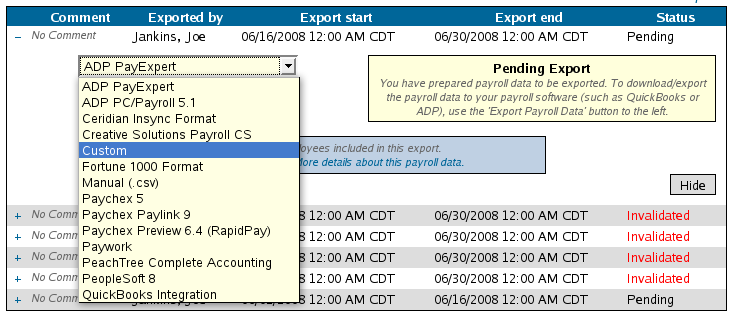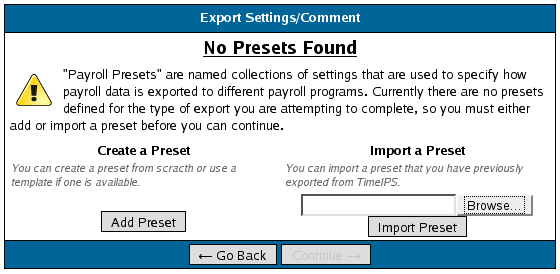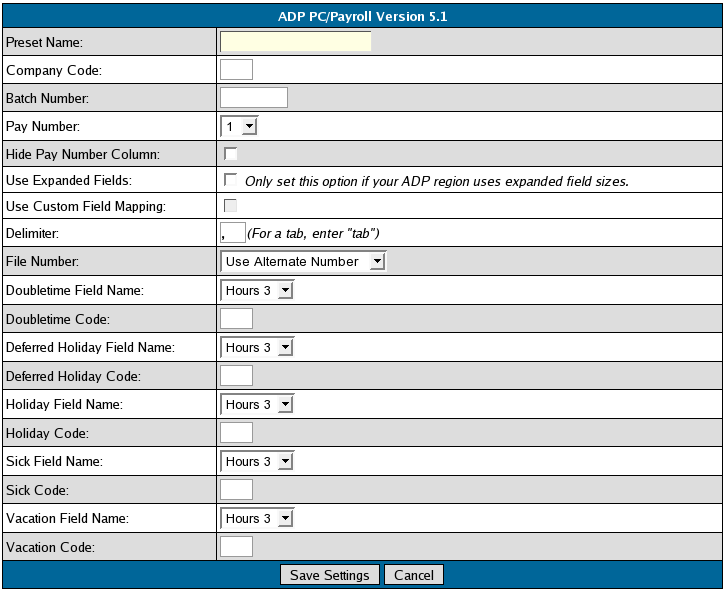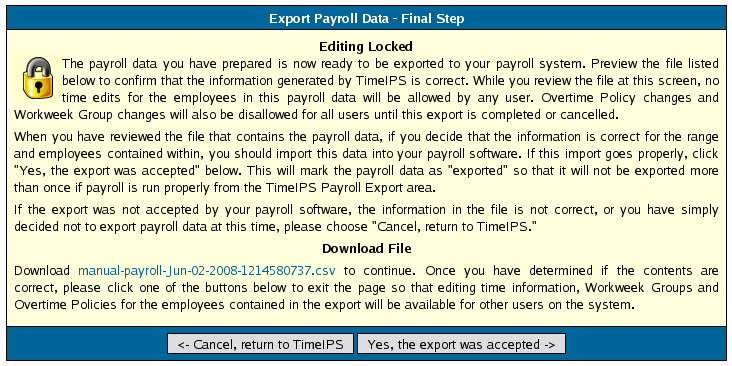
|
|
Applies to versions: 1.8, 1.9
ADP Export Settings
TimeIPS Payroll Export can generate a file with your payroll data. The file can be opened in a spreadsheet application, such as Microsoft Excel or OpenOffice Calc. Using the  Payroll Integration with Benefits Tracking (IPSQBI) optional module, the file can be imported in your ADP payroll application. Payroll Integration with Benefits Tracking (IPSQBI) optional module, the file can be imported in your ADP payroll application.
Permission: Payroll Management -> Payroll Export
Default Permission Group: Payroll Administrator
Using the left pane Main Menu, click on: Payroll » Payroll Export
Before you export:
Step 1: Select Export Contents
Select a Payroll Type and Payroll Period for the date range you are working on from the drop-down boxes and click on the button labeled Prepare Payroll for Export. Next you should see the payroll calculation being scheduled
NOTE: If necessary, it is possible to manually select your payroll time range and employees as well as change the export settings for payroll using the appropriately labeled tabs at the top of this page..
Step 2: Choose an Export Format
Select ADP PC/Payroll 5.1 from the drop down menu and then click on the button labeled Export Payroll Data
Click on Add Preset to begin setting up a preset for the ADP export
The preset window will appear.
The following export settings should be defined prior to running your ADP export:
- Preset Name: Enter the name you wish to assign to the preset.
- Company Code: Your ADP assigned Company Code; column is included in the payroll export and used to name the exported file
- Batch Number: Value used by ADP to represent a new batch of payroll data in order to prevent duplicate records on subsequent imports
- Pay Number: The Pay Number code defined by ADP
- Hide Pay Number Column: Select “Yes” to remove the Pay Number column in the export file; select “No” to include the column in the export file with the value defined in the “Pay Number” field above.
- Use Expanded Fields: Only set this option if your ADP region uses expanded field sizes.
- Use Custom Field Mapping: Requires special module
- Delimiter: A comma is the default setting. Enter "tab" to use a tab delimiter.
- File Number: Your options are "Alternate Number", "ID/Badge Number" and "Social Security Number (SSN)"
NOTE: Doubletime, holiday, sick, and vacation hours must be idenfied in ADP as "Hours 3" or "Hours 4" and given a unique identifying pay code. Those settings, as defined in your ADP application, will be identified in the Pay Code Name and Pay Code in TimeIPS.
- Doubletime Field Name: Define whether Doubletime hours are coded as “Hours 3” or “Hours 4” in ADP
- Doubletime Code: Enter the Code used to define Doubletime hours
- Deferred Holiday Field Name: Define whether Deferred Holiday hours are coded as “Hours 3” or “Hours 4” in ADP
- Deferred Holiday Code: Enter the Code used to identify Deferred Holiday hours
- Holiday Field Name: Define whether Holiday hours are coded as “Hours 3” or “Hours 4” in ADP
- Holiday Code: Enter the Code used to identify Holiday hours
- Sick Field Name: Define whether Sick hours are coded as “Hours 3” or “Hours 4” in ADP
- Sick Code: Enter the Code used to identify Sick hours
- Vacation Field Name: Define whether Vacation hours are coded as “Hours 3” or “Hours 4” in ADP
- Vacation Code: Enter the Code used to identified Vacation hours
Once your preset has been configured, click on Save Settings to save, or Cancel to exit without saving.
Step 3: Export Payroll
- On the next screen be sure that your new preset is the one selected in the Export Settings Preset drop down menu.
- Optionally if you wish to add a comment to the export making it unique and easily identifiable you can do so now.
- Click Continue
Step 4: Download Payroll Export
Note: Editing of time events is locked during payroll processing to avoid having another user make changes via the Time/Edit Report that would not be reflected properly in the current payroll run.
Click on the download link to save the newly created payroll export file.
If you have confirmed that the information contained in this export is correct and wish to permanently lock the payroll period click the button labeled Yes, the export was accepted otherwise choose Cancel, return to TimeIPS
If you chose Cancel return to TimeIPS the export will be listed as Pending. Pending exports can be exported again to other payroll output formats as often as you like until they have been finalized
If you chose Yes, the export was accepted you should now see the payroll run labeled as Exported Exported payroll runs are locked, time can no longer be edited in the system for this period of time.
|

 Information
Information Sales
Sales Support
Support Payroll Integration with Benefits Tracking (IPSQBI) optional module, the file can be imported in your ADP payroll application.
Payroll Integration with Benefits Tracking (IPSQBI) optional module, the file can be imported in your ADP payroll application. 







